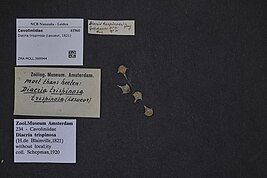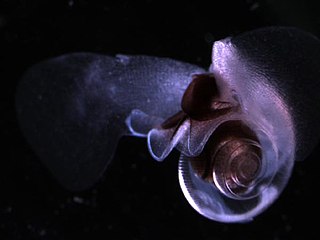
Sea butterflies, scientific name Thecosomata, are a taxonomic suborder of small pelagic swimming sea snails. They are holoplanktonic opisthobranch gastropod mollusks. Most Thecosomata have some form of calcified shell, although it is often very light and / or transparent.
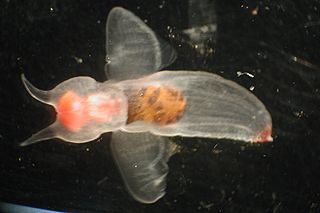
Sea angels are a large group of small free-swimming sea slugs, not to be confused with Cnidarians, classified into six different families. They are pelagic opisthobranchs in the clade Gymnosomata within the larger mollusc clade Heterobranchia. Sea angels were previously referred to as a type of pteropod.
The Notobranchaeidae, or "naked sea butterflies", are a taxonomic family of floating sea slugs, specifically under the subclass Opistobranchia, also called "sea angels".

Pteropoda are specialized free-swimming pelagic sea snails and sea slugs, marine opisthobranch gastropods. Most live in the top 10 m of the ocean and are less than 1 cm long. The monophyly of Pteropoda is the subject of a lengthy debate; they have even been considered as paraphyletic with respect to cephalopods. Current consensus, guided by molecular studies, leans towards interpreting the group as monophyletic.

A whorl is a single, complete 360° revolution or turn in the spiral or whorled growth of a mollusc shell. A spiral configuration of the shell is found in numerous gastropods, but it is also found in shelled cephalopods including Nautilus, Spirula and the large extinct subclass of cephalopods known as the ammonites.
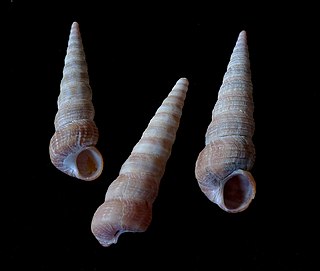
A spire is a part of the coiled shell of molluscs. The spire consists of all of the whorls except for the body whorl. Each spire whorl represents a rotation of 360°. A spire is part of the shell of a snail, a gastropod mollusc, a gastropod shell, and also the whorls of the shell in ammonites, which are fossil shelled cephalopods.

Haliotis asinina, common name the ass's-ear abalone, is a fairly large species of sea snail, a tropical gastropod mollusk in the family Haliotidae, the abalones, also known as ormers or pāua. Both the common name and the scientific name are based on the shape of the shell, which is long, narrow and curved, resembling the shape of a donkey's ear.

The family Cavoliniidae is a taxonomic group of small floating sea snails, pelagic marine opisthobranch gastropod mollusks.
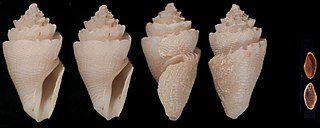
Conopleura striata is a species of sea snail, a marine gastropod mollusk in the family Drilliidae.
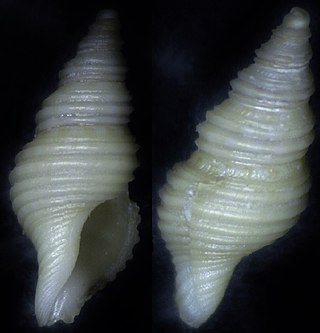
Teretia teres is a species of sea snail, a marine gastropod mollusk in the family Raphitomidae.
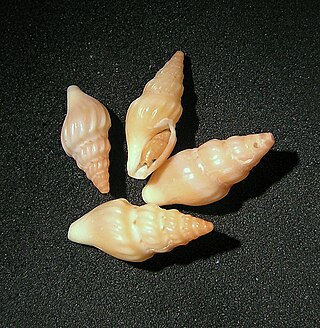
Drillia caffra is a species of sea snail, a marine gastropod mollusk in the family Drilliidae.
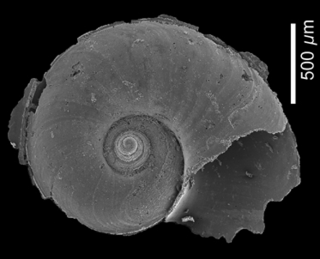
Atlanta brunnea is a species of sea snail, a holoplanktonic marine gastropod mollusk in the family Atlantidae.

Atlanta lesueurii is a species of sea snail, a holoplanktonic marine gastropod mollusk in the family Atlantidae.

Oxygyrus keraudrenii is a species of sea snail, a holoplanktonic marine gastropod mollusk in the family Atlantidae.

Protatlanta souleyeti is a species of sea snail, a holoplanktonic marine gastropod mollusk in the family Atlantidae.
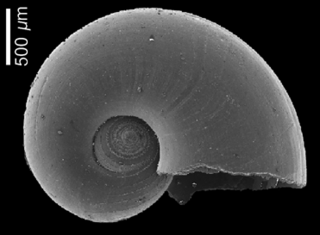
Protatlanta rotundata is an extinct species of sea snail, a holoplanktonic marine gastropod mollusk in the family Atlantidae.

Limacina helicina is a species of small swimming planktonic sea snail in the family Limacinidae, which belong to the group commonly known as sea butterflies (Thecosomata).

Halystina umberlee is a species of very small deep-water sea snail, a marine gastropod mollusc in the family Seguenziidae.

Miraclathurella vittata is an extinct Pliocene species of sea snail, a marine gastropod mollusk in the family Pseudomelatomidae, the turrids and allies. The species was discovered by Wendell Woodring in 1928.

Diacria is a genus of gastropods belonging to the family Cavoliniidae.
